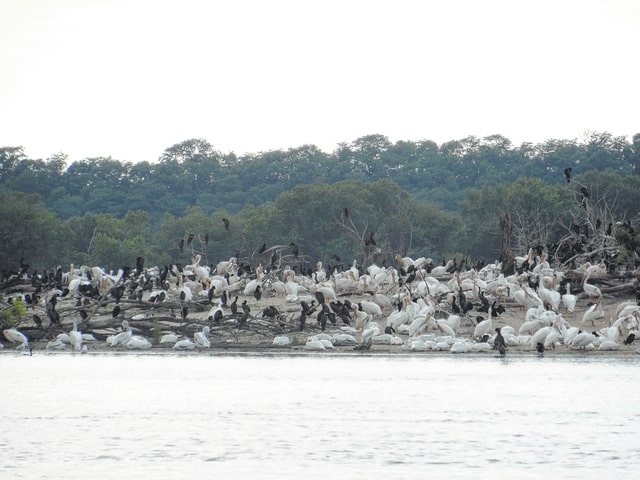

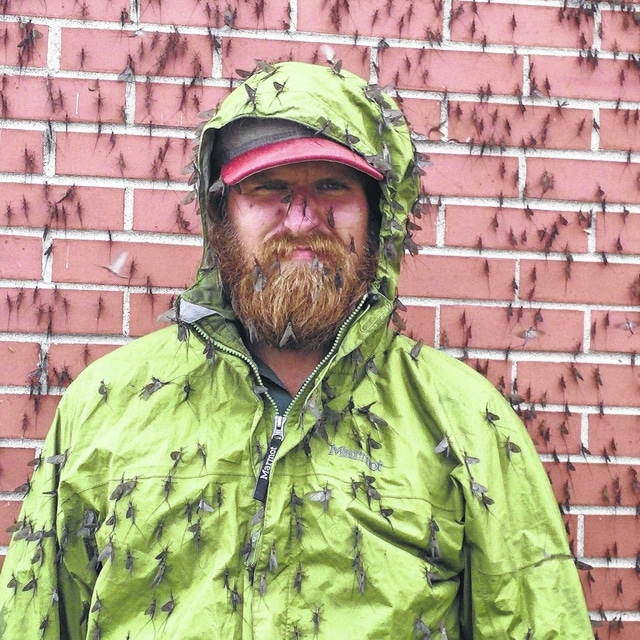
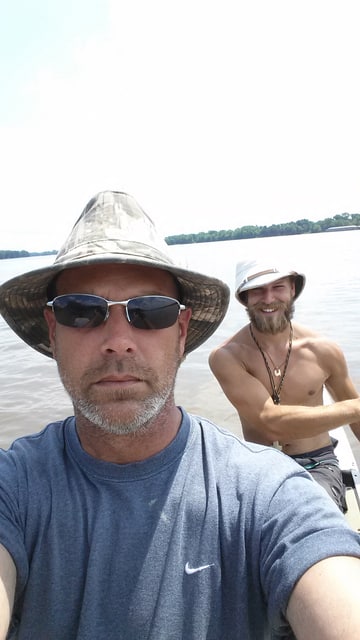
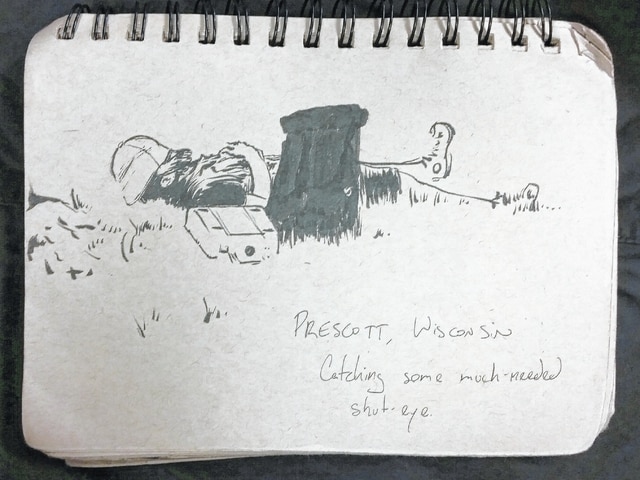
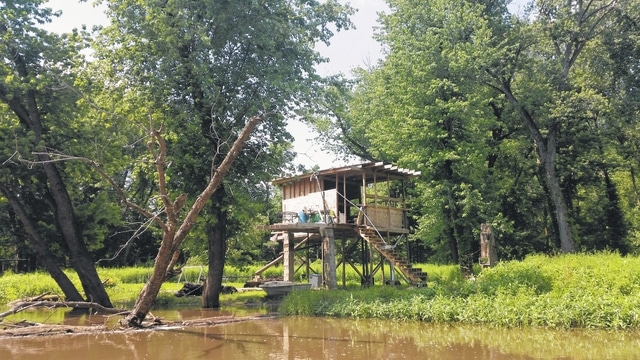
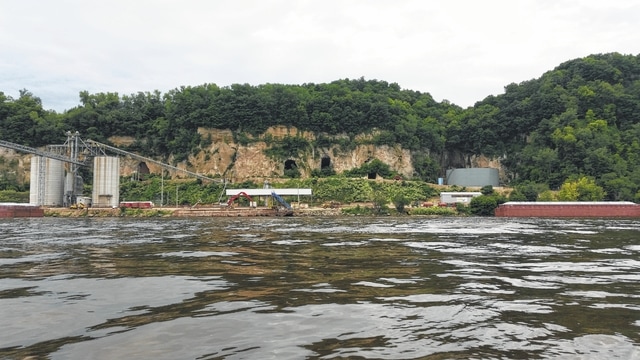
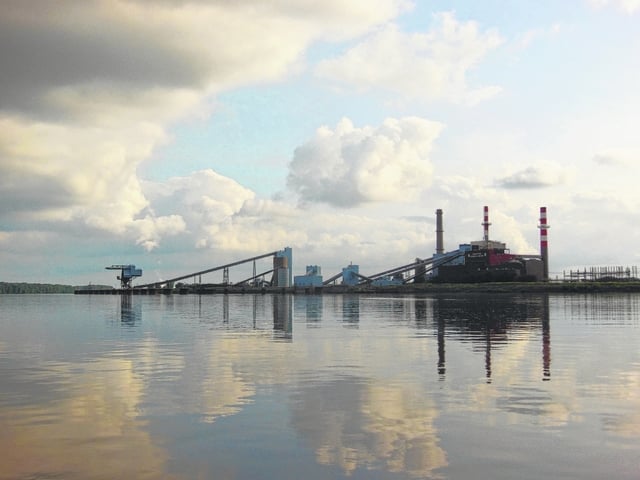


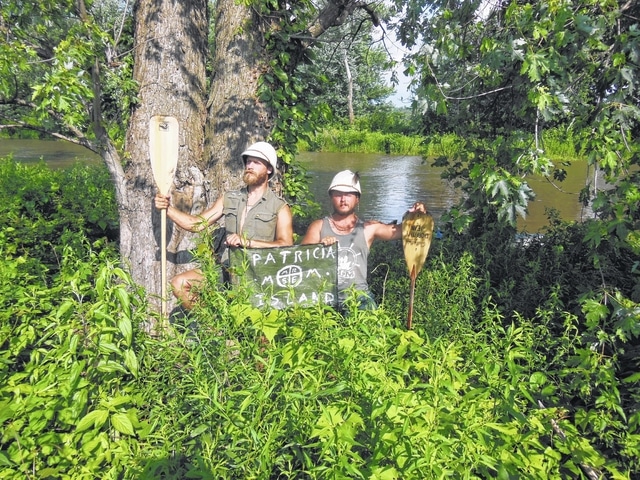
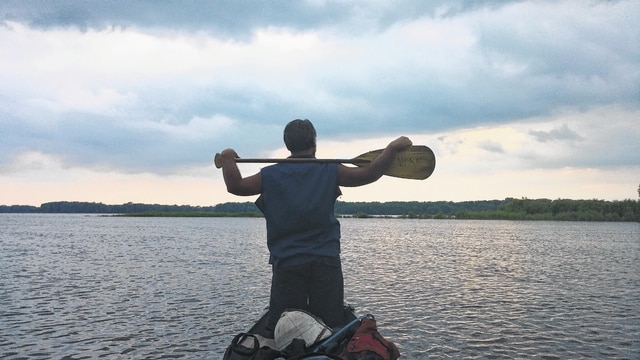
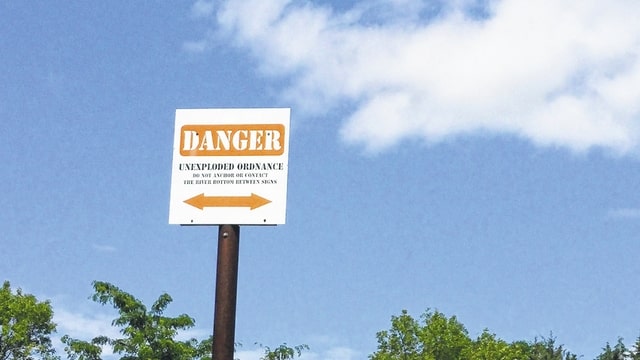
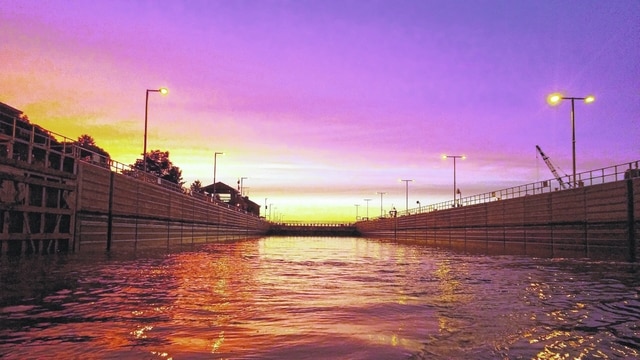

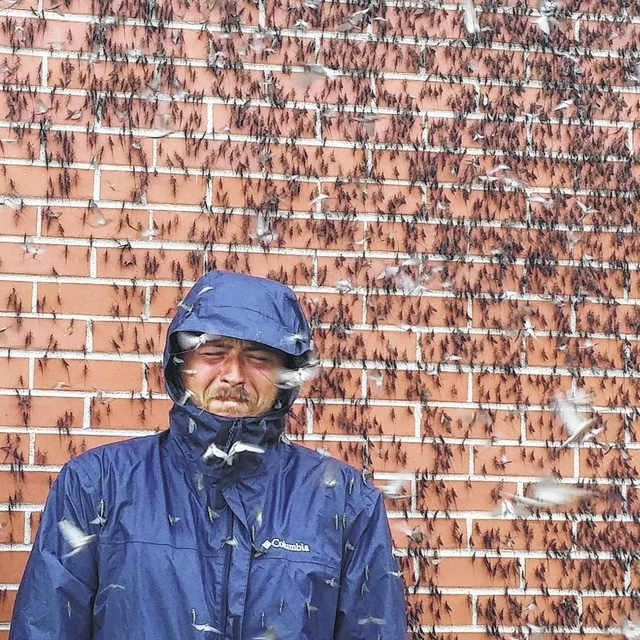
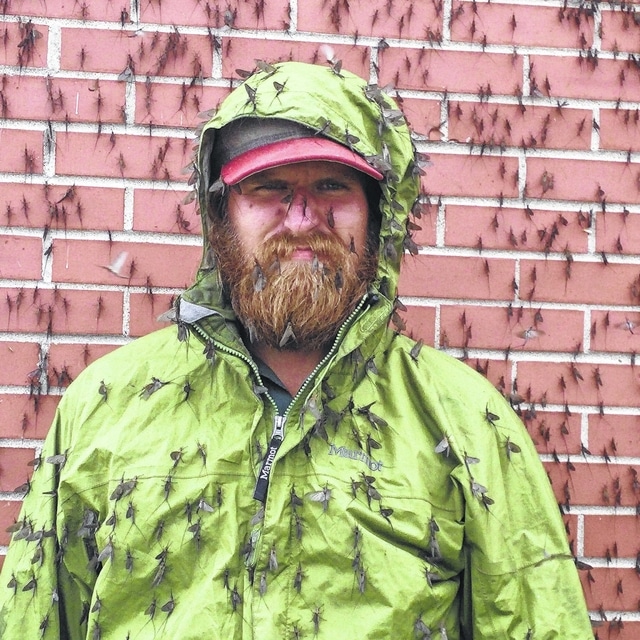

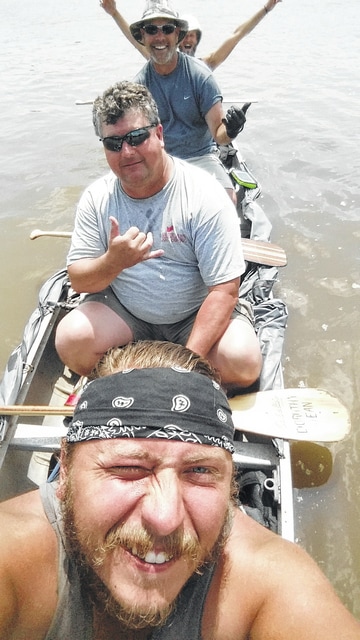
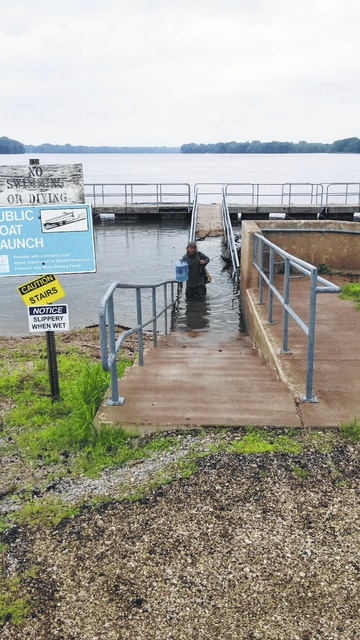


















FORT MADISON, Iowa — A visit from family and friends from Ohio and reaching the 1,000 mile mark were highlights for three adventurers this week as they continue traveling down the Mississippi River.
Forrest Schoessow, 25, of Sidney, Shea Selsor, 25, of Piqua, and Alex Ross, 26, of Sidney, began their adventure on May 20 from Lake Itasca in Minnesota. Since then they’ve traveled through Minnesota, Wisconsin, Illinois and Iowa. They expected to leave Iowa during their travels Sunday afternoon when they enter Missouri.
“We stopped for a big resupply,” said Schoessow, during their weekly phone call Sunday. “We’ve unloaded all our cold weather gear and other things, which we thought we would need, and didn’t.
“A support crew from the Miami Valley met up with us Saturday,” he said.
The three people — Scott Schoessow (Forrest Schoessow’s dad), of Sidney, and friends, Todd Kremer, of Fort Loramie, and Hayden Fast, of Troy — not only brought the trio supplies, but also helped cure a little bit of homesickness each of them has.
“They brought us some awesome supplies and boosted our morale,” said Schoessow. “They’ll be taking a lot back to Ohio for us.”
They met up with their Ohio support crew in Oquakwa, Illinois.
“We arrived on the river’s edge wondering how healthy they are. What’s their frame of mind?,” said Kremer. “Sometimes it’s all about enduring the storms and fighting on for blue skies. The mighty river is just starting to unfold.”
“It’s amazing how well the crew is getting along and functioning together in critical situations. Especially being stuck in a canoe with each other for nearly six weeks,” agreed both Scott Schoessow and Kremer.
“They are gaining knowledge and experience every day. By making smart decisions and by respecting the power of the river, they will accomplish their goal,” said a proud father, Scott Schoessow.
The paddlers traveled 260 miles last week — from Wisconsin to Iowa — and are just 30 miles from Missouri.
“We were really held up by the storms,” said Schoessow. “We’re going with the flow of the river. We made it 64 miles in one day — that was our best so far.”
Hitting the 1,000 mile mark, said Schoessow, was a boost for the entire crew. Their support crew from Ohio got to see them hit the milestone.
“We had unloaded the canoe and they hopped right in,” said Schoessow.”We went really fast and went 30 miles with our support crew helping us.
“We also hit a new speed record — 8 1.2 miles and one lock in one hour,” he said. “Being able to be here and hit 1,000 miles has been a great moment.”
Kremer and dad Schoessow helped them paddle down the river. They were in the canoe when the adventurers hit the 1,000 mile mark.
Ross said it was good to see the people from Ohio on Saturday.
“We were able to lighten our load,” said Ross. “And we got to take a shower. That was probably the best thing in the whole world.”
Ross admits that the trio “smelled terrible” from all their travels.
“The trip is wonderful but it’s very gruelling. It was wonderful being able to take a shower and try to get out all our aches and pains. It was pretty enormous.
“I’m excited to keep going,” said Ross. “the 1,000 miles was a huge one for us. We were also able to conquer our first island and it was for my mom (Patricia Ross). We put up a flag and took a photograph of it. The storms have prevented us from doing this, but yesterday (Saturday) was a nice day. We can’t leave the flags on the islands as they could clog up the environment.”
The island was officially named “Patricia” by the crew.
“We met little resistance from the native creatures, but were impressed by the ability of waterfowl to organize an effective counterattack,” said Ross. “This was a big highlight of the week for us.”
They were also able to send out some hand crafted cards they made, with some poems and sketches for people who have helped them with the trip.
“We want to do more projects like this, but the storms have prevented us,” said Ross.
Selsor said the rain has held them up some, but they are still able to make good mileage each day on the river.
“There’s more current,” said Selsor. “We are locked into our schedule and we want to keep on pace. We just need the river’s and the weather’s cooperation.”
The trio is seeing first hand the destruction that Mother Nature can cause on the Mississippi River.
“The water is very high and flooded,” said Schoessow. “There’s been a lot of destruction with the winds and rainfall. There have been paths cut through the islands by tornadoes. Trees have been cut in half.
“We have to be very diligent of our surroundings so we can keep missing the trees in the river,” he said.
Ross said the river is very high and flowing fast.
“It’s interesting to see how it flows,” said Ross. “It’s gruelling as ever and the river is faster.”
Selsor said the current is still manageable.
“There’s a lot more stuff in the water,” he said. “Anything that wasn’t tied down has been swept into the river. There’s whole giant trees in the river.
“It’s still been manageable for paddlers. Once we get past St. Louis, we’ll have to worry because some of the river has been closed to pleasure boats.”
“There is flooding throughout this part of the Mississippi River, and we are hearing reports that is much worse further south, where we are headed. We are concerned about lock and dam closures due to high water. According to the USGS gauges, the river level (stage) has reached critical flood level, and the forecast shows nothing but rain for the next six days. We could be in for a wild ride over the coming days. Currently, all the dams on this stretch of the river are wide open to allow the rushing water to travel down,” said Schoessow.
Selsor said the river is between 1 1/2 to 2 miles across. The location they travel in the river depends on the current.
“The current goes from shore to shore,” said Selsor. “We’re also directed by the areas that have been dredged for the barges. The high water flows past that.”
There are also many turns in the river, which they have to be aware of.
“Sometimes it’s not effective to stay in the main current,” said Selsor. “We just try to find a good section of the water and stay in that.”
They are also seeing an increasing number of boats on the river, which means they stay away from the middle of the river.
“It’s tough to avoid them,” said Selsor. “We then stick close to the sidelines because you can’t always see the pleasure boats. It’s easy to see the barges.”
Ross said they all wake up sore each morning from their travels.
“We sing and do word games to distract ourselves as we paddle down the river,” said Ross.
“At Lock and Dam No. 18, a tree trunk entered the lock with us and slammed into the lock doors which prevented the lock master from opening the doors entirely. Sometimes these drifting logs are nearly 4 feet in diameter and submerged. This makes them very difficult to see coming. It’s a real threat, and we have to remain vigilant and aware of our surroundings at all times during floods. We are navigating using Army Corps of Engineers navigation charts, which are very detailed and help us negotiate the more treacherous stretches. These are the same charts used by barges and military vessels,” said Schoessow.
When they come into a city, they take precautions to make sure nothing happens to their canoe and supplies.
“It’s been amazing how helpful the people are,” said Ross. “We have to trust the Americans with what we’re doing. We hide the boat, which is not easy to hide. We have to trust the people of the river.”
Another milestone during the week, said Selsor, was when they passed 80-year-old paddler Dale Saunders and his crew. Saunders is traveling down the Mississippi River also and a film crew is chronicling his trip.
“We stopped and talked to them,” said Selsor. “He has hosted paddlers in Memphis and he decided to do the trip. He’s doing it for juvenile diabetes awareness.
“There was a press conference after we went through a lock with them. It was interesting meeting him. It was amazing that he was doing this at his age.”
Selsor said Saunders didn’t have much gear with him and he was paddling the canoe by himself.
The Department of Natural Resources, said Schoessow, is also keeping track of the trio.
“The DNR has checked up on us,” he said, “to make sure we’re safe and alright. They have been very polite and helpful and have given us some tips.”
Ross said they are seeing more wildlife and less aquatic life such as beavers and otters.
“We’re seeing turkeys and deer. There are also clams and muscles in the river,” he said. “There are invasive species in the river, which have killed off a lot of species. It’s cool to see the endangered species making it.
The DNR, said Ross, is also checking their canoe for “hitchhikers.”
“They are making sure we’re not dumping or are home to an aquatic hitchhiker,” said Ross. “A clam or curly weed can ruin an entire area.”
Ross said during their travels during a 70-80 mile stretch of the river, 80 percent of it was a wildlife refuge.
Schoessow said the river towns they have traveled through have a lot of history attached to them. They stayed in Le Claire, Iowa, during a story. Le Claire is the hometown of Buffalo Bill.
Le Claire, he said, holds a three-day festival each year which includes a tug of war over the Mississippi River. The rope goes from shores of the river in Iowa to the shore in Illinois and each team tries to pull the other team into the river.
“We met an apprentice river pilot who taught us many things about the history of steamboat navigation up and down the Mississippi River,” said Schoessow. “He was working aboard a steamboat that still uses the original steam engine that was constructed over 100 years ago. The steamboat had come in to port due to the storms, just as we did.
“There was a massive swarm of adult mayflies that greeted us when we landed on shore. Thousands upon thousands of these insects, which live for less than 24 hours as adults, covered the shores, buildings, boats, and in the end… us. Sometimes there are so many of these insects that they appear as clouds on local weather radar,” he said.
They also visited the Port of Burlington, Iowa, which is the hometown of Aldo Leopold, an ecologist and environmentalist.
“We called at the Port of Burlington in Iowa, and visited the local museum documenting the town’s river and conservation histories. This town was once a crucial steamboat port and connected river commerce to the railroads leading east,” said Schoessow.
“Aldo Leopold, one of America’s greatest naturalists and a hero of mine, was also born here. He was a outdoorsman and writer who helped develop the National Forest Service, Wilderness Society, and Department of Game Management. His book ‘Sand County Alamanac,’ which describes the many ways that mankind and the environment are connected, has often been described as the single most influential piece of writing conservation and environmentalism. Leopold suggested that humans were part of a larger natural community, and helped us understand our responsibilities as stewards of the environment. He developed the concept of a ‘Land Ethic,’ and described conservation as ‘a state of harmony between men and the land’,” said Schoessow.
The support crew from Ohio was surprised by the work done by the barges on the river.
“The efficiency of barge commerce is very impressive. The Mississippi River still plays a huge role in the agriculture sector and is important for all the small river towns that produce crops for export,” said Kremer.
Each year over 1.1 billion bushels of corn, 389 million bushels of soybeans, and 32 million bushels of wheat are transported to the Gulf via the Mississippi River. More than 85 percent of the corn and soybeans exported from the United States are transported by barges down the Mississippi River.
“It’s really great to see how far the Midwest work ethic has taken many of these river communities, and the hospitality of the locals who never fail to help these boys out reminds me of home in the Miami Valley,” said Scott Schoessow.
Ross has continued his sketching during the week, and because of the delays from the storms, has been able to document some quotes from the people he is drawing.
“We have met some wonderful people,” said Ross. “One of those people was a bar operator. We had to stop for a horrible storm. We walked to the top of the hill. The owner, a Korean War veteran, opened his bar up for us. We had a dry place to wait out the storm.”
They have camped at Buena Vias, a wildlife refuse across from Debuque, Port Louisa Wildlife Refuse Camp and Oquawka, Illinois.
Ross said he’s been surprised by the evolution of the bridges on the river.
“There are old train bridges which are quite low,” he said. “They have been adapted and retrofitted so they can raise like a drawbridge.
“Some of the bridges have been abandoned and flowers and trees are growing on them,” he said. “It’s quite beautiful.
While in Iowa, the “critter” the crew honored was the Iowa Plesistocene Snail.
The critter for Illinois is the Rattlesnake Master-Borer Moth. This moth is like a canary in a coal mine for the prairies of the Midwest. It only feeds on one plant, the rattlesnake-master, and this plant only grows in undisturbed prairies environments. If these moths are disappearing, that means that healthy prairie-land is disappearing as well. Prairies help filter water and remove elements harmful to humans.
In Missouri, they will be saluting Hine’s Emerald Dragonfly, which is a threatened species right now. The dragonfly is an extremely rare insect that was once thought to be extinct. This species, which preys upon pests, is facing extinction due to pesticide use.
As they enter Missouri, travels will also intersect with parts of Illinois.
The highlight of the week, said Schoessow, was “having people from our hometown here. It was
great to see the people from home. It was great to hear their perspective on what’s going on during our trip.
“They’ve also seen that we’re OK and in a healthy frame of mind,” he said. “They paddled 30 1/2 miles with us. They were amazed at how difficult it can be.”
Ross said they best thing their Ohio friends and family brought to them was themselves.
“It was wonderful to see fresh faces from home,” said Ross. “The energy and the questions they brought was wonderful. I think they were pleased with what they saw.
“I think they are as excited as we are about the trip,” he said. “But the most important thing is what they are taking away. We’ve trimmed our stuff. We came ‘loaded for bear’ since we didn’t know what to expect. We now have a lighter boat and will be able to carry more water since they brought us a new jug. We are now set for the rest of our trip.”
Selsor said it was fantastic seeing someone from home.
“We were getting supplies and ditching some of the weight in the canoe,” he said. “It was a great stop. We try to make each one as productive as possible.
“We also have to balance the things we’re doing for our supporters with the mileage we still have to do,” said Selsor. “I’d like to thank the people who continue to donate and are supporting us.”
Ross said he is looking forward to visiting Hannibal, Missouri, the birthplace of Mark Twain.
“I think we’re going to stay there overnight,” said Ross. “We met someone from Hannibal Saturday and we were invited to hangout with them.”
The trip can be followed on their website, http://mrexpedition.squarespace.com and on Facebook, https://www.facebook.com/m.r.s.expedition. The Sidney Daily News has also linked up with the expedition’s Facebook account on its site, https://www.facebook.com/SidneyDailyNews.

